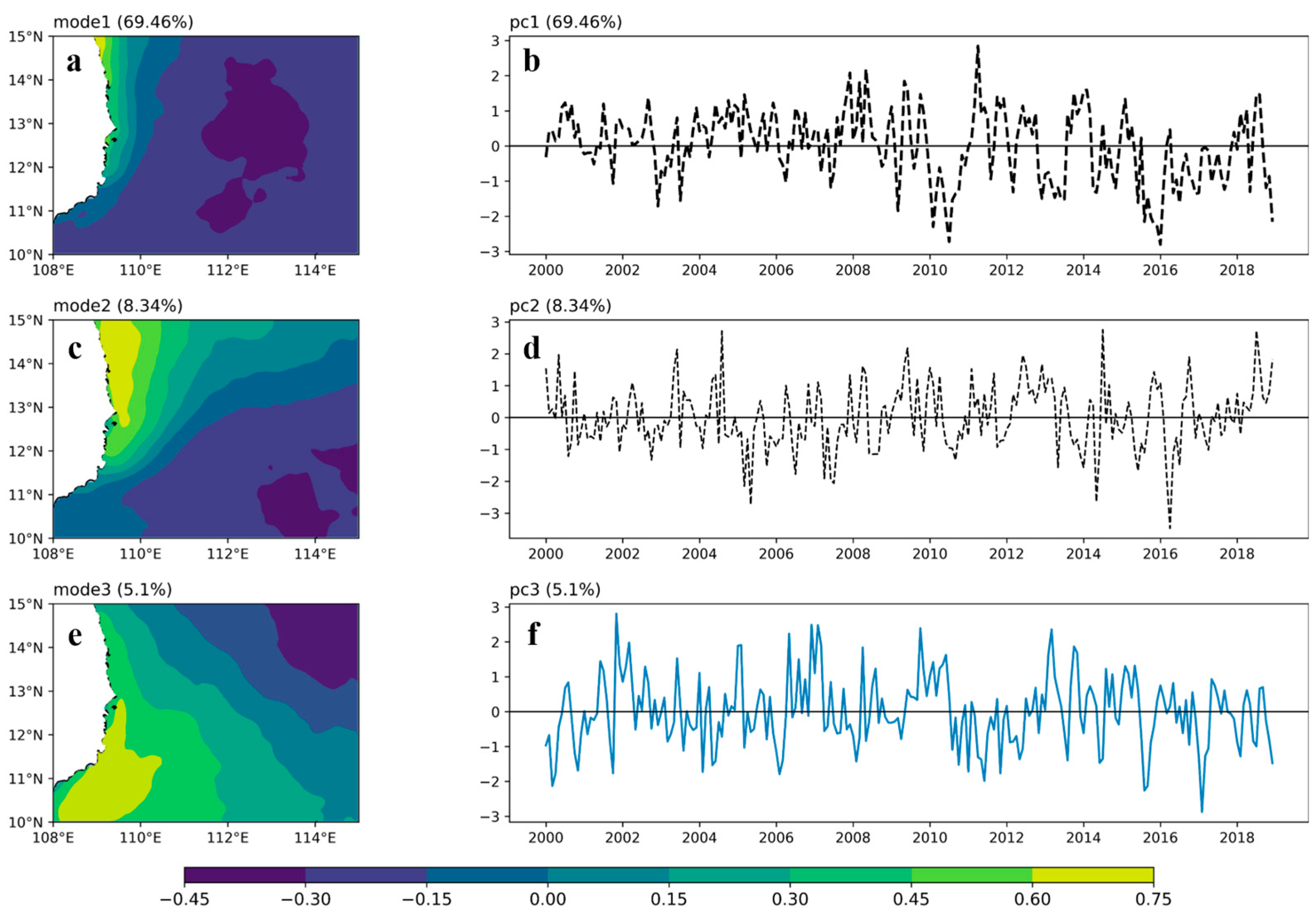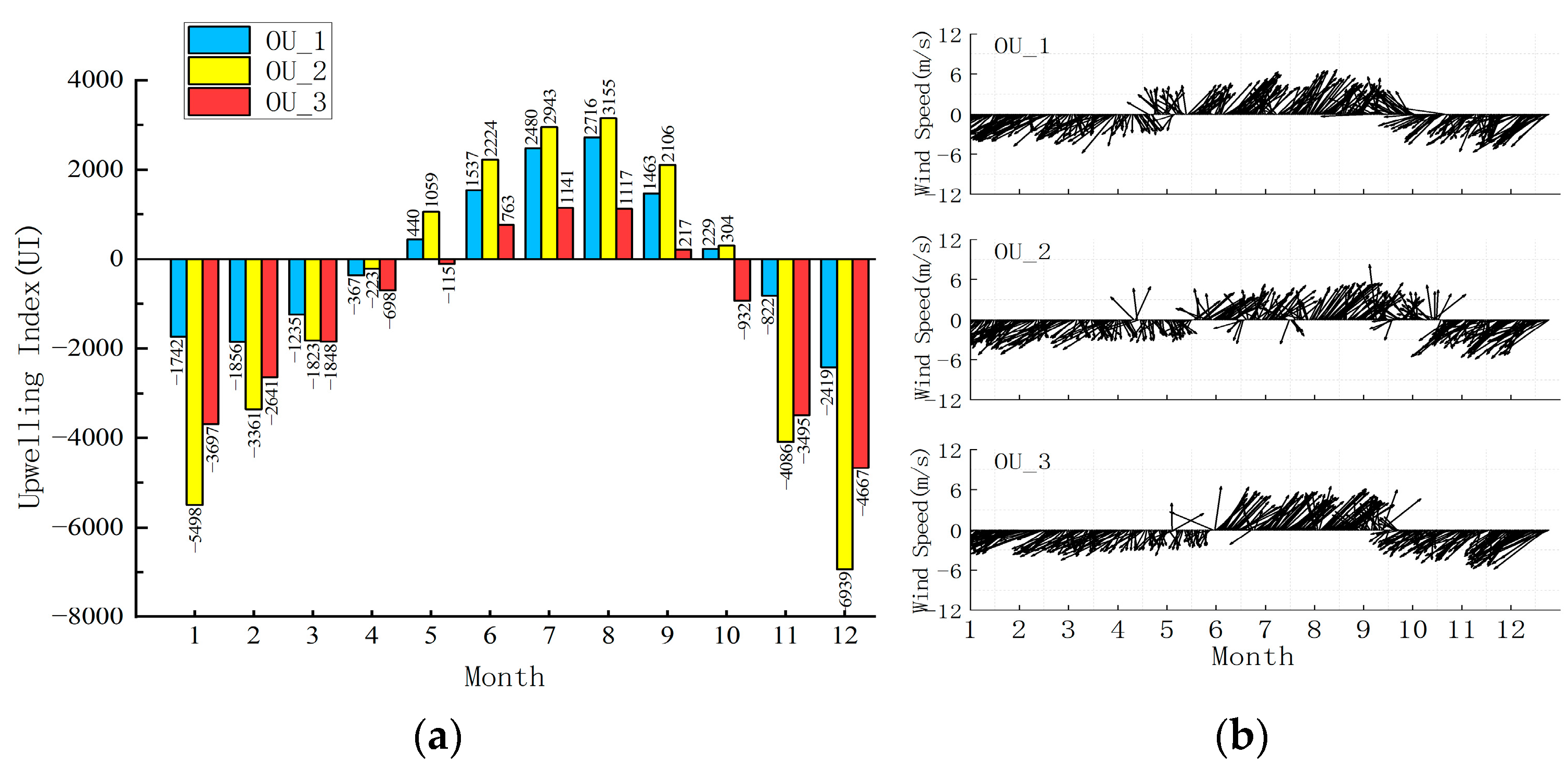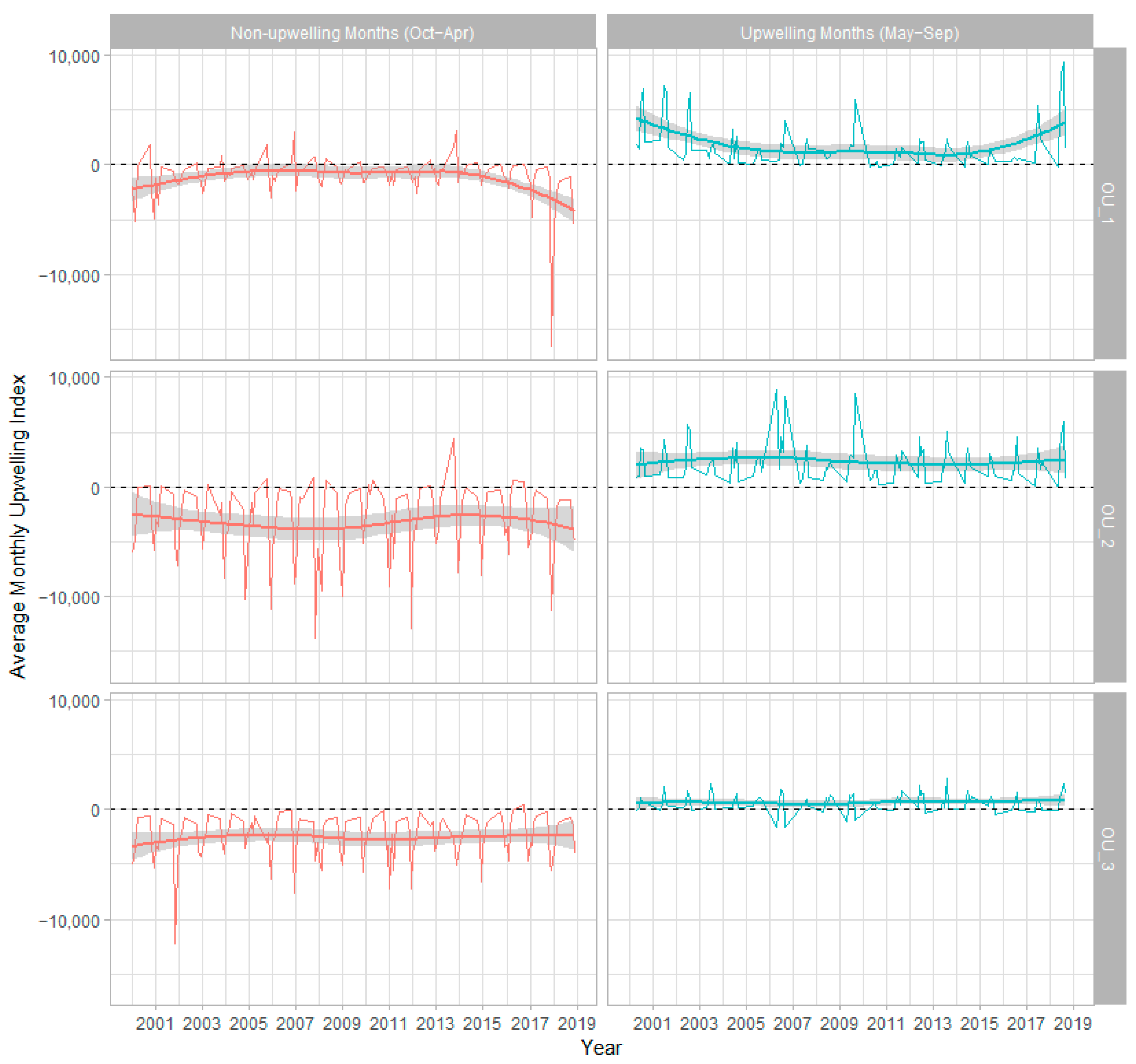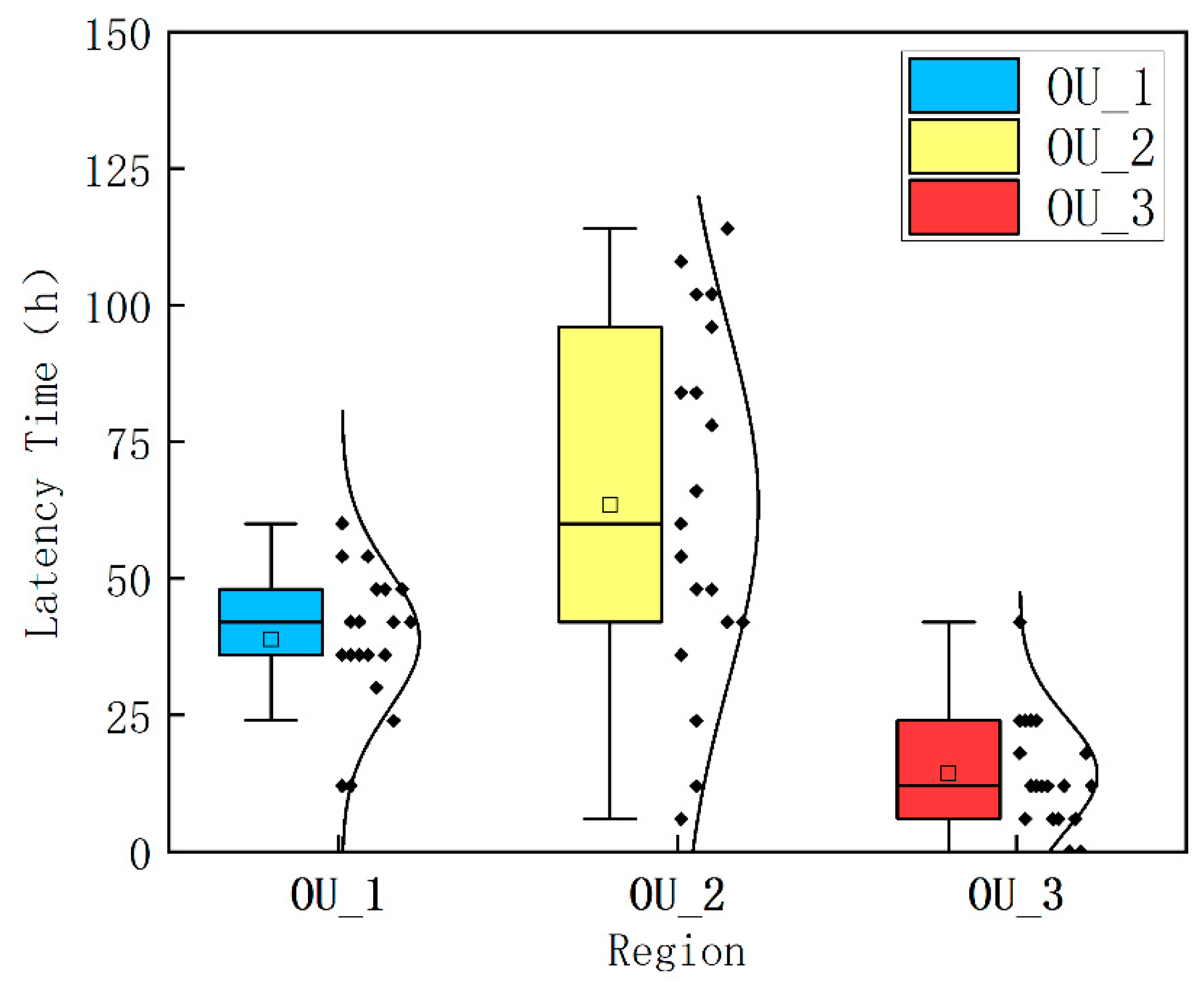Spatial and Temporal Variability of Upwelling in the West-Central South China Sea and Its Relationship with the Wind Field
Abstract
Featured Application
Abstract
1. Introduction
2. Data and Methods
2.1. Study Area Data
2.2. Methods
2.2.1. Identification Method of Upwelling
2.2.2. Empirical Orthogonal Function Decomposition (EOF)
2.2.3. Wind-Based Upwelling Index
2.2.4. Correlation Analysis
3. Results
3.1. Spatial and Temporal Characteristics of Upwelling in the West-Central South China Sea
3.2. Effect of Wind Fields on Upwelling
4. Conclusions
Author Contributions
Funding
Institutional Review Board Statement
Informed Consent Statement
Data Availability Statement
Acknowledgments
Conflicts of Interest
References
- Narvekar, J.; Roy Chowdhury, R.; Gaonkar, D.; Kumar, P.K.D.; Prasanna Kumar, S. Observational evidence of stratification control of upwelling and pelagic fishery in the eastern Arabian Sea. Sci. Rep. 2021, 11, 7293. [Google Scholar] [CrossRef] [PubMed]
- Schroeder, I.D.; Santora, J.A.; Mantua, N.; Field, J.C.; Wells, B.K.; Hazen, E.L.; Jacox, M.; Bograd, S.J. Habitat compression indices for monitoring ocean conditions and ecosystem impacts within coastal upwelling systems. Ecol. Indic. 2022, 144, 109520. [Google Scholar] [CrossRef]
- Hu, J.Y.; Wang, X.H. Progress on upwelling studies in the China seas. Rev. Geophys. 2016, 54, 653–673. [Google Scholar] [CrossRef]
- Xu, L.Q.; Ji, C.; Kong, D.M.; Guo, M. Abrupt change in Vietnam coastal upwelling as a response to global warming. J. Quat. Sci. 2021, 36, 488–495. [Google Scholar] [CrossRef]
- Wyrtki, K. Physical Oceanography of the Southeast Asian Waters; University of California, Scripps Institution of Oceanography: La Jolla, CA, USA, 1961; Volume 2. [Google Scholar]
- Kuo, N.-J.; Zheng, Q.; Ho, C.-R. Satellite observation of upwelling along the western coast of the South China Sea. Remote Sens. Environ. 2000, 74, 463–470. [Google Scholar] [CrossRef]
- Hu, C.; Feng, L.; Lee, Z. Uncertainties of SeaWiFS and MODIS remote sensing reflectance: Implications from clear water measurements. Remote Sens. Environ. 2013, 133, 168–182. [Google Scholar] [CrossRef]
- Groom, S.; Sathyendranath, S.; Ban, Y.; Bernard, S.; Brewin, R.; Brotas, V.; Brockmann, C.; Chauhan, P.; Choi, J.-k.; Chuprin, A. Satellite ocean colour: Current status and future perspective. Front. Mar. Sci. 2019, 6, 485. [Google Scholar] [CrossRef]
- Akhir, M.F.; Daryabor, F.; Husain, M.L.; Tangang, F.; Qiao, F. Evidence of upwelling along Peninsular Malaysia during southwest monsoon. Open J. Mar. Sci. 2015, 5, 273–279. [Google Scholar] [CrossRef]
- Kuo, N.J.; Zheng, Q.; Ho, C.R. Response of Vietnam coastal upwelling to the 1997-1998 ENSO event observed by multisensor data. Remote Sens. Environ. 2004, 89, 106–115. [Google Scholar] [CrossRef]
- Yang, H.J.; Liu, Q.Y.; Jia, X.J. On the upper oceanic heat budget in the South China Sea: Annual cycle. Adv. Atmos. Sci. 1999, 16, 619–629. [Google Scholar]
- Rueda-Roa, D.T.; Muller-Karger, F.E. The southern Caribbean upwelling system: Sea surface temperature, wind forcing and chlorophyll concentration patterns. Deep Sea Res. Part I Oceanogr. Res. Pap. 2013, 78, 102–114. [Google Scholar] [CrossRef]
- García-Reyes, M.; Largier, J. Observations of increased wind-driven coastal upwelling off central California. J. Geophys. Res. Ocean. 2010, 115. [Google Scholar] [CrossRef]
- Kajikawa, Y.; Wang, B. Interdecadal Change of the South China Sea Summer Monsoon Onset. J. Clim. 2012, 25, 3207–3218. [Google Scholar] [CrossRef]
- Healy, T.R. Coastal Wind Effects. In Encyclopedia of Coastal Science; Schwartz, M.L., Ed.; Springer: Dordrecht, The Netherlands, 2005; pp. 312–313. [Google Scholar]
- Reynolds, R.W.; Smith, T.M.; Liu, C.; Chelton, D.B.; Casey, K.S.; Schlax, M.G. Daily high-resolution-blended analyses for sea surface temperature. J. Clim. 2007, 20, 5473–5496. [Google Scholar] [CrossRef]
- Huang, B.; Liu, C.; Freeman, E.; Graham, G.; Smith, T.; Zhang, H.-M. Assessment and intercomparison of NOAA daily optimum interpolation sea surface temperature (DOISST) version 2.1. J. Clim. 2021, 34, 7421–7441. [Google Scholar] [CrossRef]
- Bentamy, A.; Piolle, J.; Prevost, C. Product User Manual for Wind Product WIND_GLO_WIND_L4_REP_OBSERVATIONS_012_006; Copernicus Marine Service: Toulouse, France, 2018; Volume 1, p. 26. [Google Scholar]
- Bentamy, A. Quality Information Document for Wind Product WIND_GLO_WIND_L4_REP_OBSERVATIONS_012_006; Copernicus Marine Service: Toulouse, France, 2021. [Google Scholar]
- Tao, S.Q.; Liu, J.T.; Wang, A.J.; Blattmann, T.M.; Yang, R.J.; Lee, J.; Xu, J.J.; Li, L.; Ye, X.; Yin, X.J.; et al. Deciphering organic matter distribution by source-specific biomarkers in the shallow Taiwan Strait from a source-to-sink perspective. Front. Mar. Sci. 2022, 9, 969461. [Google Scholar] [CrossRef]
- Alvarez, A.; Lopez, C.; Riera, M.; Hernandez-Garcia, E.; Tintore, J. Forecasting the SST space-time variability of the Alboran Sea with genetic algorithms. Geophys. Res. Lett. 2000, 27, 2709–2712. [Google Scholar] [CrossRef]
- Gomez-Gesteira, M.; Moreira, C.; Alvarez, I.; DeCastro, M. Ekman transport along the Galician coast (northwest Spain) calculated from forecasted winds. J. Geophys. Res. Ocean. 2006, 111. [Google Scholar] [CrossRef]
- Ngo, M.H.; Hsin, Y.C. Impacts of Wind and Current on the Interannual Variation of the Summertime Upwelling Off Southern Vietnam in the South China Sea. J. Geophys. Res. Ocean. 2021, 126, e2020JC016892. [Google Scholar] [CrossRef]
- Xi, C.P.; Zhang, S.N.; Gang, X.; Zhao, H.C.; Yang, Y.H. Two-dimensional multifractal cross-correlation analysis. Chaos Solitons Fractals 2017, 96, 59–69. [Google Scholar] [CrossRef]
- Wang, D.X.; Shu, Y.Q.; Xue, H.J.; Hu, J.Y.; Chen, J.; Zhuang, W.; Zu, T.T.; Xu, J.D. Relative contributions of local wind and topography to the coastal upwelling intensity in the northern South China Sea. J. Geophys. Res. -Ocean. 2014, 119, 2550–2567. [Google Scholar] [CrossRef]
- Barlow, D.R.; Klinck, H.; Ponirakis, D.; Garvey, C.; Torres, L.G. Temporal and spatial lags between wind, coastal upwelling, and blue whale occurrence. Sci. Rep. 2021, 11, 6915. [Google Scholar] [CrossRef]
- Jing, Z.Y.; Qi, Y.Q.; Du, Y.; Zhang, S.W.; Xie, L.L. Summer upwelling and thermal fronts in the northwestern South China Sea: Observational analysis of two mesoscale mapping surveys. J. Geophys. Res. -Ocean. 2015, 120, 1993–2006. [Google Scholar] [CrossRef]
- Fu, B.; He, X.; Yao, H.; Liang, Y.; Deng, T.; He, H.; Fan, D.; Lan, G.; He, W. Comparison of RFE-DL and stacking ensemble learning algorithms for classifying mangrove species on UAV multispectral images. Int. J. Appl. Earth Obs. Geoinf. 2022, 112, 102890. [Google Scholar] [CrossRef]
- Fu, B.; Sun, J.; Wang, Y.; Yang, W.; He, H.; Liu, L.; Huang, L.; Fan, D.; Gao, E. Evaluation of LAI Estimation of Mangrove Communities Using DLR and ELR Algorithms With UAV, Hyperspectral, and SAR Images. Front. Mar. Sci. 2022, 9. [Google Scholar] [CrossRef]








| Wind Direction | Wind Speed | Wind Stress | Radial Wind Speed | Latitudinal Wind Speed | |
|---|---|---|---|---|---|
| Center longitude of the upwelling | −0.175 ** | 0.102 ** | 0.130 ** | −0.037 | 0.248 ** |
| Central latitude of the upwelling | 0.012 | −0.086 ** | −0.078 ** | −0.309 ** | 0.181 ** |
Disclaimer/Publisher’s Note: The statements, opinions and data contained in all publications are solely those of the individual author(s) and contributor(s) and not of MDPI and/or the editor(s). MDPI and/or the editor(s) disclaim responsibility for any injury to people or property resulting from any ideas, methods, instructions or products referred to in the content. |
© 2023 by the authors. Licensee MDPI, Basel, Switzerland. This article is an open access article distributed under the terms and conditions of the Creative Commons Attribution (CC BY) license (https://creativecommons.org/licenses/by/4.0/).
Share and Cite
Shi, J.; He, H.; Fan, D.; Xiong, Y.; Xiao, B.; Zhang, J. Spatial and Temporal Variability of Upwelling in the West-Central South China Sea and Its Relationship with the Wind Field. Appl. Sci. 2023, 13, 5383. https://doi.org/10.3390/app13095383
Shi J, He H, Fan D, Xiong Y, Xiao B, Zhang J. Spatial and Temporal Variability of Upwelling in the West-Central South China Sea and Its Relationship with the Wind Field. Applied Sciences. 2023; 13(9):5383. https://doi.org/10.3390/app13095383
Chicago/Turabian StyleShi, Jinke, Hongchang He, Donglin Fan, Yuankang Xiong, Bin Xiao, and Jie Zhang. 2023. "Spatial and Temporal Variability of Upwelling in the West-Central South China Sea and Its Relationship with the Wind Field" Applied Sciences 13, no. 9: 5383. https://doi.org/10.3390/app13095383
APA StyleShi, J., He, H., Fan, D., Xiong, Y., Xiao, B., & Zhang, J. (2023). Spatial and Temporal Variability of Upwelling in the West-Central South China Sea and Its Relationship with the Wind Field. Applied Sciences, 13(9), 5383. https://doi.org/10.3390/app13095383





